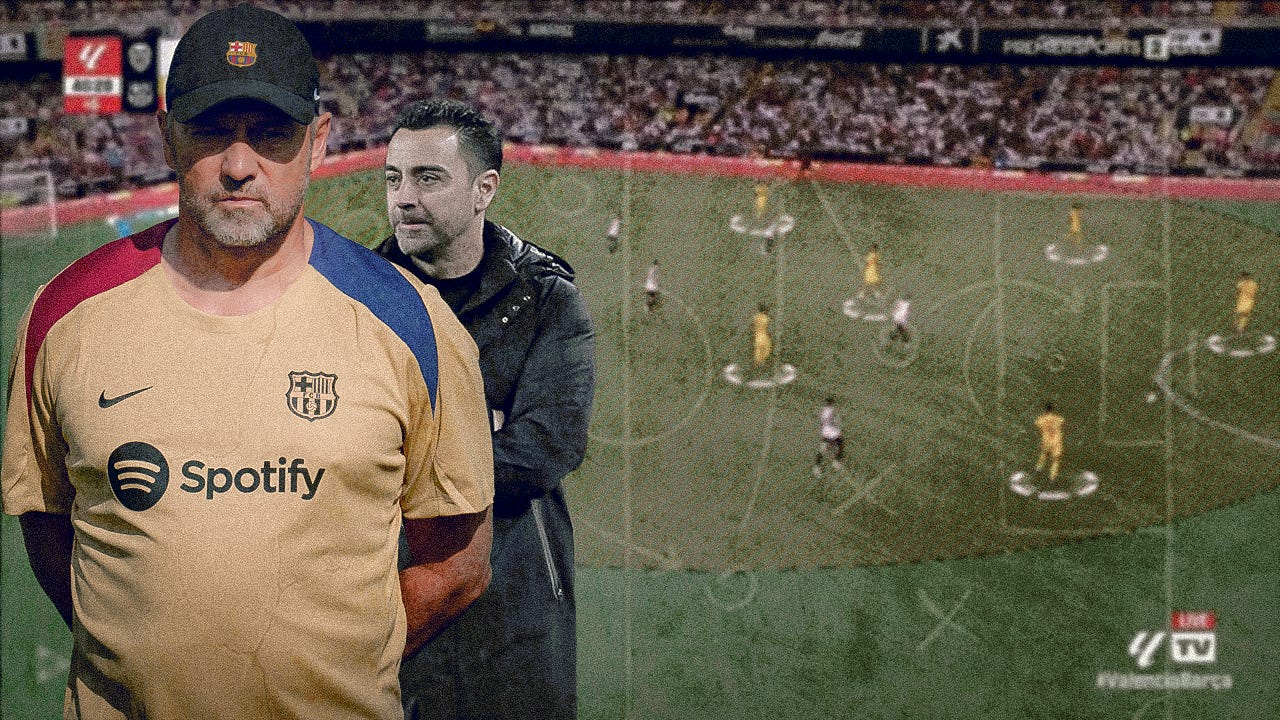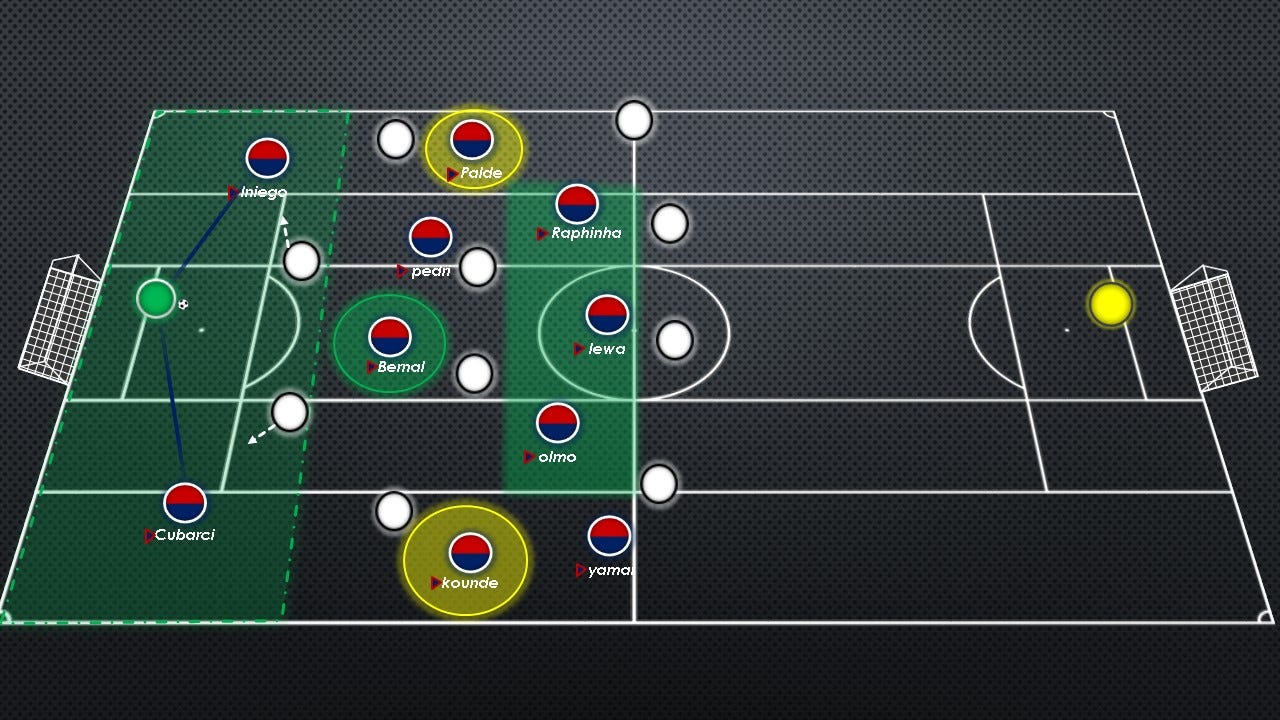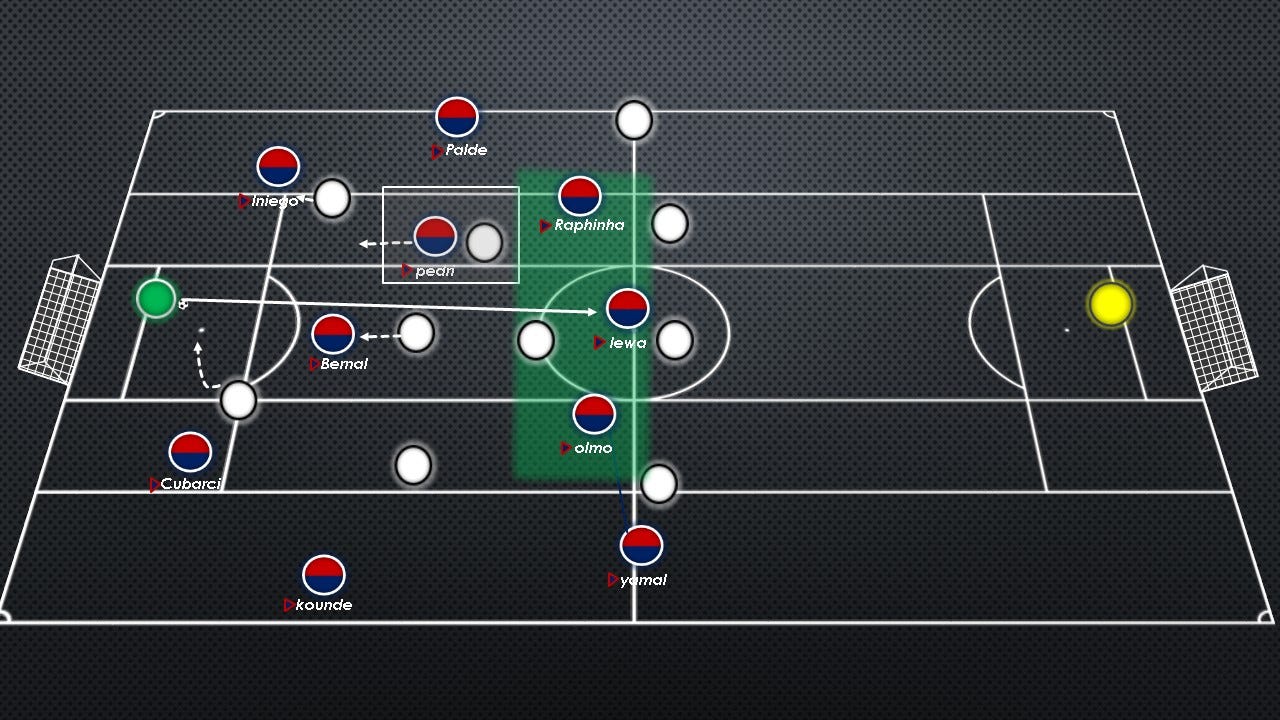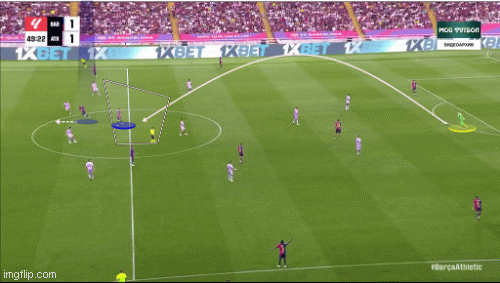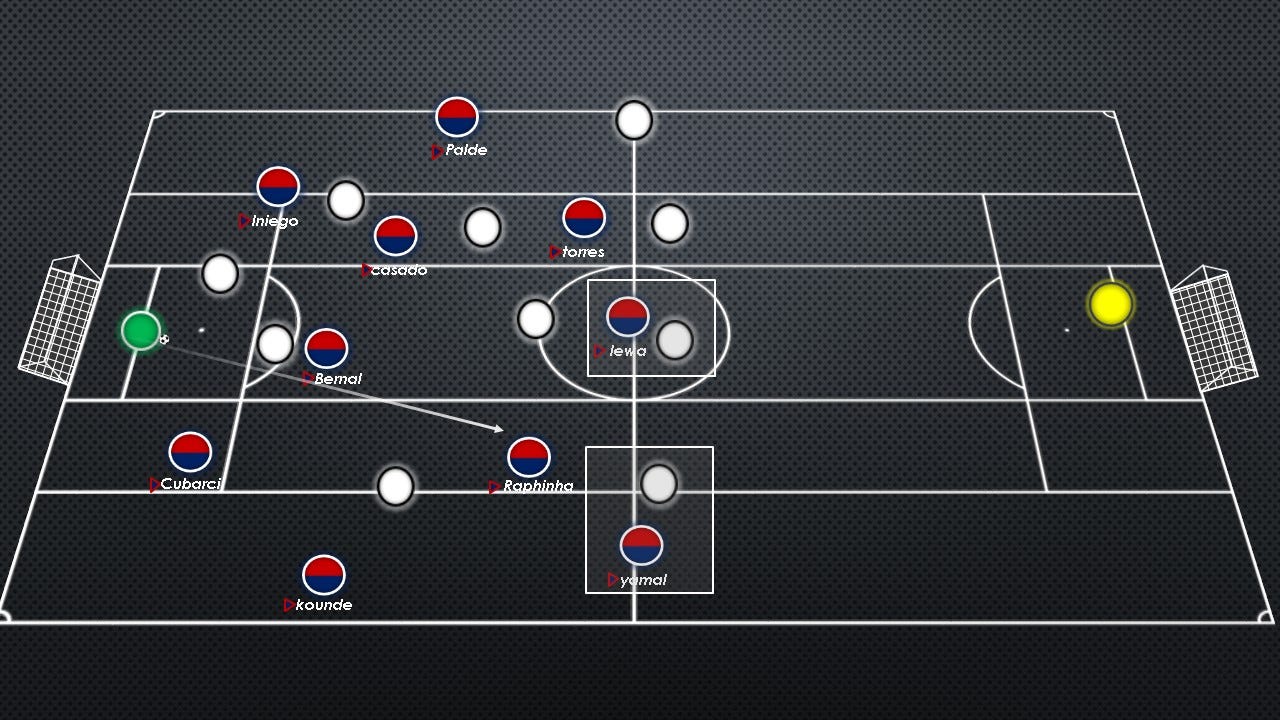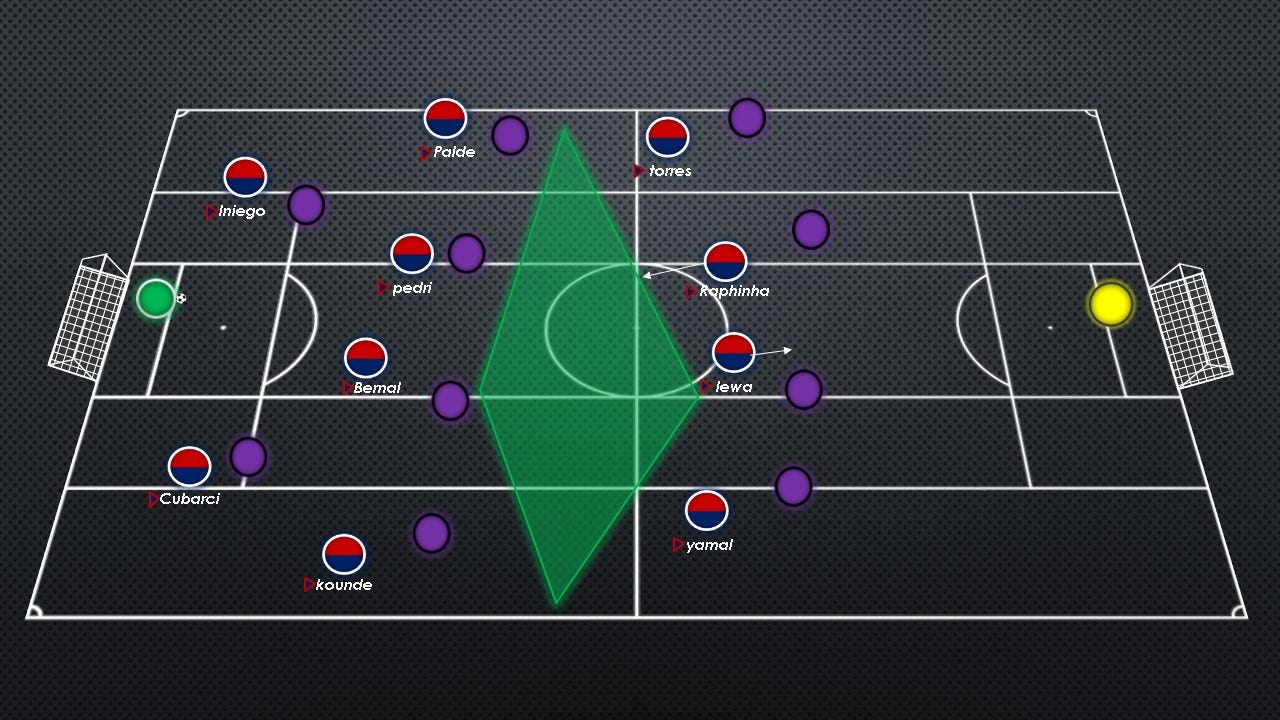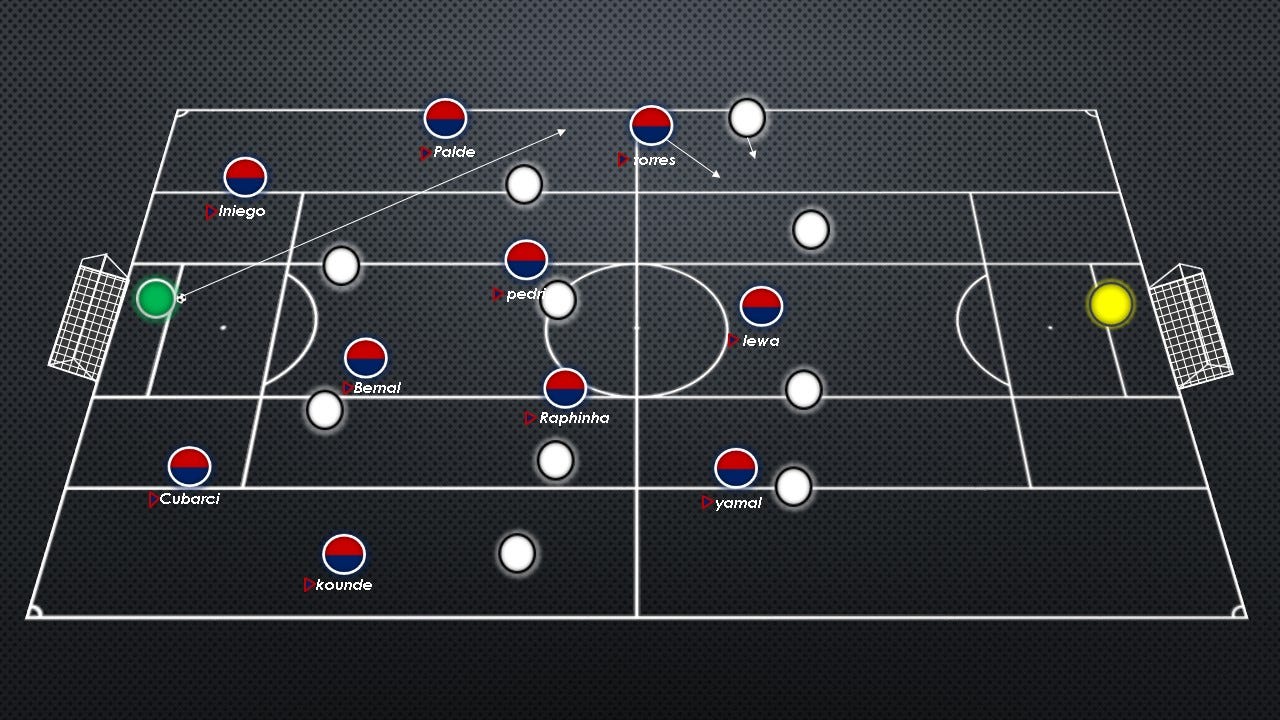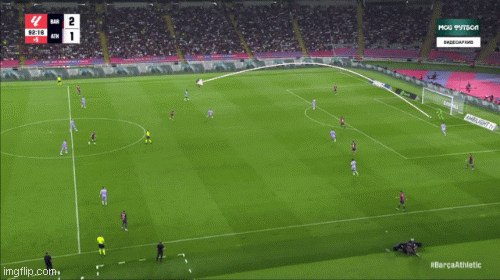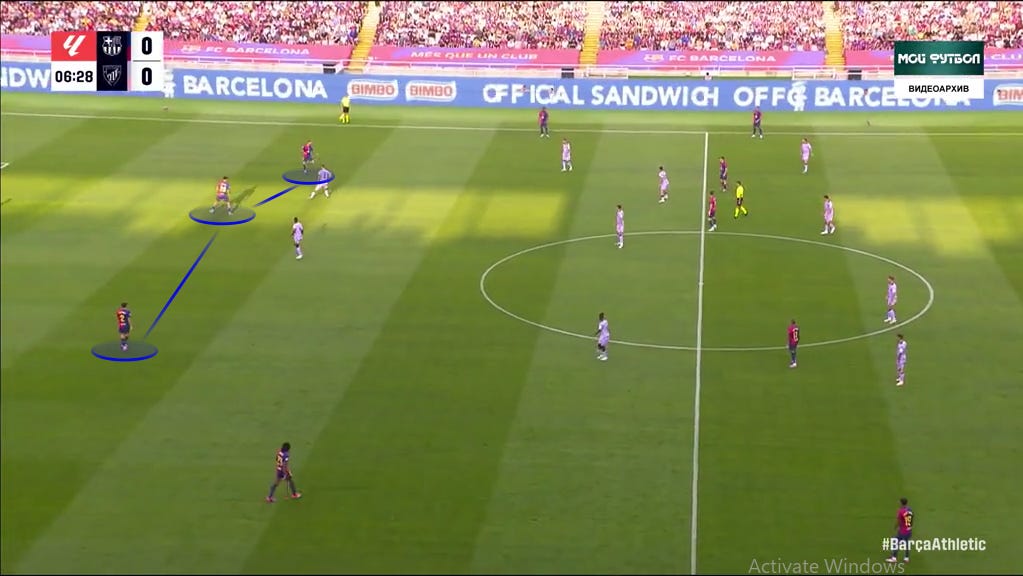Flick's Tactics: How He Revolutionized Barcelona's Playing Style
Tactical Analysis of Hansi Flick's Period with Barcelona .
Hansi Flick is considered one of the most prominent coaches in modern football, having achieved remarkable success at club and national team levels. Following his successful tenure with Bayern Munich, he is now coaching Barcelona, opening up new horizons for the Catalan team. Flick brings his unique style of play, characterized by tactical flexibility and organized attack, making him an ideal choice for rebuilding and improving the team's performance. In this report, we will analyze the tactics relied upon by Hansi Flick and how it could impact Barcelona's performance in domestic and European competitions. We will also examine his strategies in managing matches and player deployment, reflecting his vision as a coach aiming to achieve victories and enhance the team's identity Now, let's discuss Barcelona's playing phases analysis with Hansi Flick and how the team transitions between these playing phases.
Hansi Flick's style is more direct and features fewer touches to reach the opponent's goal. It also includes high pressing and counter-pressing, which Barcelona has excelled at recently. This approach effectively prevents the opponent from progressing and maintaining possession of the ball for long periods, suffocating them to control the match and dictate play
Barcelona is the highest-ranked team in the top seven leagues in terms of pressing (PPDA), with a value of 5.9, which is an incredible figure I haven't seen before for any team! Meaning of the statistic: Barcelona allows the opponent to complete fewer than 6 passes before making a defensive intervention to regain possession of the ball.
It is the team with the highest number of goals scored in the top five leagues.
Barcelona in La Liga after 5 rounds:
Most goals scored: 17
Highest xG: 12.9, and highest xG without penalties: 12.1
Most shots: 95, with 35 on target
Most chances created: 73
Most passes into the penalty area: 63
Second highest in dribbles: 61
Second lowest number of shots conceded: 34
Barcelona is the fourth most dangerous team in making tackles in the final third among the top five leagues.
Barcelona is one of the leading teams in making vertical passes, However, it is highly effective, as the team delivers the highest number of through passes in the top five leagues, indicating their efficiency. which highlights what we've mentioned about Flick's direct style.
It is the team in La Liga that recovers possession the most in the opponent's third.
Barcelona is at the top of La Liga in terms of possession spells, which indicates that the team not only employs a direct approach to advance the ball but also maintains possession. This creates a wonderful blend of controlling the ball and the opponent.
These statistics reflect Hansi Flick's identity with Barcelona and further clarify his playing style. Now, let's move on to explaining the Phases of play.
(Build Up Phase)
we will now discuss hansi flick ideas in the build up phase and how he interacts with different pressing structures
valemcia’s press :
Valencia presses Barcelona in a 4-4-2 or 4-1-3-2 formation. one of the forwards applies curved pressure on the goalkeeper and closes passing angles for the defender, while the second forward is positioned close to the other defender, Inigo Martinez. The two midfielders from Valencia are responsible for marking Barcelona's midfielders (Pedri and Bernal). Additionally, there is a player positioned near Barcelona's right-back, Konde, but he is more centrally located to be ready to pressure any midfielder if the ball reaches them or to press Konde when necessary
“how Barcelona bypassed this press?”
Barcelona, during their buildup play against this common pressure strategy used by most teams today (5+2 with the goalkeeper), aims to attract the opponent's pressure to create space in the depth of the attacking third. In this area, Barcelona enjoys both numerical and qualitative superiority with three players, as well as forming a 2v1 situation against the opponent's full-back. pedri drops back to receive the ball, while Yamal quickly moves in to receive it from Lewandowski.
As shown in the video below Barcelona created a dangerous opportunity through a direct buildup play, which Yamal missed.
some examples of the same pattern from other matches
The second idea Ter Stegen and the other players, as we mentioned earlier, regarding the opponent's pressure. Raphinha drops into half-spaces, putting the opponent's winger in a dilemma: whether to stick with Koundé or to press him. Meanwhile, Yamal positions himself high to pin down the opponent's full-back, allowing Raphinha the freedom to receive the ball. This is a form of the direct style that Flick employs .
The third idea involves Barcelona exploiting the presence of the opponent's wingers to close the passing lane to Barcelona's number 10 (Raphinha). This allows the Barcelona full-back (Koundé) to remain free, enabling him to receive the ball and exit the pressure effectively.
In the fourth scenario, Barcelona attempts to escape from the flanks by widening the space between the two center-backs, which creates more distance and space for the opponent under pressure. One center-back receives the ball with time and space, while the opponent's winger moves to pressure the full-back. This allows midfielder Casado to move freely behind the opponent’s pressure. He then plays a third-man pass between himself and the winger to Balde, who attacks the half-space after moving into the area vacated by Torres, who has drawn the opponent's full-back away.
some examples of the same pattern from other matches
Rayo Vallecano press :
Rayo Vallecano employs a different pressing strategy using a 4-2-3-1 or 4-4-1-1 formation. The forward presses the goalkeeper in a curved manner, closing the passing angle to defender Iñigo. The opposing playmaker is responsible for marking Bernal; when the ball is passed to the free defender, the playmaker starts to leave Bernal and shifts to press the defender while closing passing angles towards the pivot. The player responsible for Pedri pressures Bernal, and then the player responsible for Balde moves to press Pedri, focusing the pressure on the ball location. Meanwhile, the wingers position themselves more centrally next to Barcelona's full-backs, ready to apply pressure. Rayo enjoys a numerical advantage in their defense against Barcelona's attackers, with a 4 against 3, and when Lewandowski drops back, a defender follows him.
First solution :Yamal here tries to draw the opponent's full-back slightly into the depth to create space on the flanks for Kounde who move behind rayo vallecano winger. This allows Koundé to receive the diagonal ball from Ter Stegen, similar to the previous example we discussed regarding Valencia in the earlier scenario.
second solution :When Cuparsi receives the ball, Rafinha drops and drags the defender with him. Cuparsi plays the ball at the same moment. Kounde moves behind the winger. The third man ball is played between them and Barça gets out of the pressure with quick passes.
Third solution: Yamal drops back, pulling the full-back with him, while Raphinha drags the defender marking him in the front line, creating space in the center. Koundé then moves inward to exploit that space and executes a wall pass with Yamal.
The case below explains this.
Fourth solution: Konde pulls the winger and then gives Cuparsi space and time on the ball to advance, then with the transfer of players, the direction of play begins to change towards the full-back, who expands the width of the field as a result of the numerical load of isolation.

The case below explains this.
Fifth solution: When the player marking Bernal moves to pressure Kobarcy, Bernal makes a run behind him to create space between himself and the other player who is tracking him, making for a suitable passing option.
The case below explains this.
The case below explains this.
Here, Bernal drops back as a third defender and moves in a similar manner, creating triangles between the players, similar to a third man play as in the scenario below.
Girona press:
As we can see, Girona is pressing high, so Barcelona tries to draw the pressure further in order to free up space for Lewandowski or Raphinha to drop back. This pulls a defender with them, while Pedri moves into position to receive quickly through a third man pass. Fast exchanges allow Barça to break free from the pressure.
Also, the same idea but with a different application. Here, Barcelona attempts to create a numerical advantage in the second line in the midfield, where Pedri, Yamal, and Olmo form a 3 vs. 2 situation. This also gives them a central superiority in the midfield. Pedri quickly receives the ball from the goalkeeper, plays it to the wing, and Barça escapes Girona's pressure with three direct passes.
The same idea applies here: drawing the pressure and sending the ball to the striker who drops into the vacant space to receive it.
Here Ter Stegen tries to stimulate the opponent's pressure when the attacker presses, he passes to Casado who receives with a turn, and at the same moment here there will be movements and dynamics in the middle of the field as Olmo runs and Rafinha falls in his place and drags the defender with him, so Yamal falls to receive the ball freely and Kounde runs behind the winger, great dynamics and speed in the passes to get out of the pressure .
Here we also see Ter Stegen's patience with the ball to attract the opponent's pressure, then we see the extent of the central superiority in the depth of the field, Pedri, Rafinha, Leiva, and Casdo, and also the full-back Balde, Rafinha quickly falls from his marker to receive the ball, and with the third man play for Balde, who became free as a result of the marker's pressure on Rafinha, who quickly fell, then with a three-man play also from Balde to Rafinha, then he moves.
Here also another idea with the pressure conservation and Barcelona going out on the side, a set of dynamic movements takes place to empty the free man who receives the ball. Here we see Cuparsi receiving the ball on the side and Girona besieged man to man in the ball area, so Olmo falls and pulls a marker with him to empty space and open a passing path for Yamal who also enters the depth to form a numerical advantage and receive the ball (we see in the picture a numerical superiority of 3 against 2 Olmo and Pedri) and also Yamal and Lewandowski falls to pull the marker and with the third man play, Pedri comes out the free man and passes the ball to Rafinha who is also free as a result of Lewa pulling the two central defenders and the ball is played to him after that, great dynamics and speed in breaking the pressure is wonderful .
Athletic Bilbao press:
Athletic Bilbao, in this match, mostly applied a mid-block press, and the moments when the team pressed high were rare and filled with gaps. Athletic Bilbao pressed in a 4-4-2 structure. We saw the two forwards pressing Barcelona's center-backs, while the wingers pressured Barcelona's full-backs, palde and Koundé. The midfielders from Athletic Bilbao pressed Bernal and Pedri, and their marking wasn't strictly man-to-man. When Pedri left his position, the Athletic Bilbao player didn't follow him but remained stationed in that space.
bilbao had a clear weakness: the space between their lines was too large. This often led to numerical superiority for Barcelona's attackers against Bilbao's defenders, allowing Barcelona to exploit this space when progressing the ball. They did so by positioning one player, either Lewandowski or Raphinha, centrally to pin Bilbao's defenders, while the other would move forward to pull the defensive line, allowing the other to drop into the space, becoming the free man and providing an outlet for the team.
As shown in the gif above, Barcelona set up in their usual 4-2 shape, with Pedri dropping deeper to form a double pivot alongside bernal. This created a triangle on the flank between Balde, Pedri, and Iñigo Martínez. The ball moved from Iñigo to Pedri, with Balde acting as the free man. Notice the massive space between the lines in which Fermín López was positioned. Balde then played it to Raphinha, who lay it off to López.
The same idea is repeated below, but Balde passed it directly to Fermín López, who then provided a through ball to Raphinha.
The alternative idea, similar to Rayo's approach, was to progress the ball through the full-backs.
The case below explains this.
(Progression Phase)
as the team moved past the build-up phase, they applied several tactical ideas to progress the ball effectively toward the final third.
Under Flick, the Blaugrana utilized a 3-1-6 structure during the progression phase, which sometimes varied to a 3-1-5-1, 3-1-3-3, or a 2-1-7 formation.
In this structure, we see Koundé, the right-back, moving inside as an RCB alongside Cuparci as the CCP and Iniego as the LCB. The left winger shifts inside as an inverted winger, while Balde, the LB, pushes up to maintain width with the winger, Lamine Yamal, on the opposite side, as shown in the picture on the right. Occasionally, Pedri drops alongside Bernal to form a double pivot, as shown in the picture on the left, or Marc Bernal shifts into defense as ccp with Cuparci and Martínez, allowing Pedri to act as the single pivot. This setup gives Koundé the freedom to advance and support Lamine Yamal. Koundé adapts his positioning based on Lamine's movements: remaining in the right half-space when Lamine stays wide or moving to the right flank when Lamine cuts inside, as shown in the picture on the right.
This shape in the progression phase provides central control and flexibility, allowing Barcelona to stretch themselves both horizontally and vertically across the pitch, along with positional interchanges between the players and the number 10, who has the freedom to roam. This creates passing lanes, making it difficult for the opposition to defend against.
With six players positioned higher up, it effectively utilizes width, stretching the opponent's defense and creating space. This formation often leads to numerical superiority in critical areas, enhancing the team's ability to create chances while maintaining fluidity through the lone pivot connecting defense and attack.
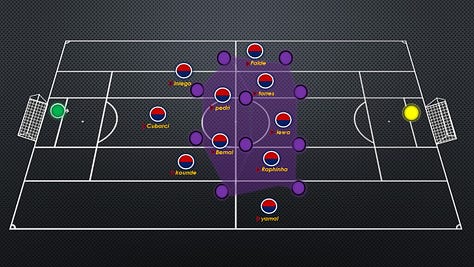

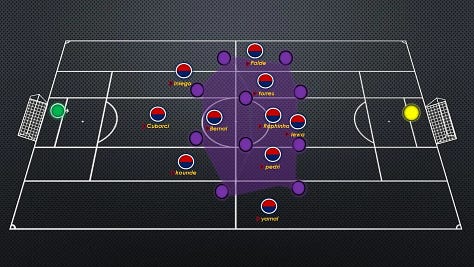
Bernal drops as a third defender alongside Cuparci and Íñigo
“maximum and minimum width”
Barcelona, under Flick, frequently applies the "both maximum and minimum width" tactic during the progression phase and the final third phase.
This tactic enables Flick to create numerical overloads in central areas by having multiple players in-depth and between the lines, with Lewandowski pinning the center-backs. At the same time, the inside winger and the pivot are positioned in the inner corridors, while the number 10 player is situated in the middle between them, allowing for positional rotation among the three players and the striker. This places the opponent in a significant dilemma, forcing their full-backs to stay narrow alongside the center-backs. Simultaneously, two players are positioned on the flanks. This dual approach enables Barcelona to disrupt the opponent's defensive structure. this gives Barcelona variety in progressing the ball from the center or from wide areas.
central progression:
1- vertical and breaking line passes
Barcelona often tries to make penetrating passes through the defenders, taking advantage of the opponent's positioning to create spaces. This allows them to send passes to the midfield trio positioned centrally, which creates a numerical superiority in the midfield with a 3 against 2 advantage.
2- diagonal passes
Barcelona aims to send diagonal balls towards the flanks by having Yamal penetrate centrally, while Raphinha and Lewandowski hold off the defenders. This creates space and time for the winger or full-back on the flanks.
3- Overload to isolate
Barcelona is trying overload to isolate To isolate a free man who has time and space at the end
4- Third man
Barcelona heavily relies on the third man movement due to the strength of their defenders in delivering vertical passes and their proximity to the midfield. This allows them to transition quickly from ball progression to the final third. They often use this tactic by having Lewandowski or Raphinha, who are positioned centrally, drop back to receive the ball from the defense and then play it out to the flanks with a single touch, as seen in the situation below.
5- Give and go
Barcelona attempts to play short passes among themselves to entice the opponent’s pressure and create space, a technique known as "give-and-go." Their close proximity and strong dynamics enable them to do this effectively, allowing them to penetrate the opponent's defense, as seen in the example.
6- Fourth man
Barcelona also employs the fourth man movement in a similar manner to the third man movement previously described. This strategy involves additional players making themselves available to create space and options, enhancing their attacking dynamics.
7- Lure and release
This idea is used to disrupt the defense and encourage them to pressure a specific player, thereby opening up space for other players to receive the ball or move freely.
Wide Progression:
Barcelona is also trying to penetrate through the flanks, attempting to create a series of movements in the midfield to distract the opponent and free up space for another player to move into. This is done through a series of passes and movements between the fullback, a midfielder, and the winger. In the case below, Raphinha drops back when Koulibaly receives the ball, and then Yamal moves into the space that has been cleared, waiting for the pass, but it doesn't come. However, here Koundé receives the ball, Yamal drops back, and Raphinha moves into the half-spaces or the area between the fullback and the defender as a result of pulling the fullback and the winger. Then, a triangular play occurs between Koundé, Yamal, and Koundé enters the depth, reaching Raphinha
Another idea from the progression of the players is that it also includes complex plays between the full-back, the midfielder, and the winger. When the full-back receives the ball from the defender, he quickly moves like the midfielder Casado behind the opponent's defense and receives the ball from the full-back, then with one touch passes it to the winger Torres after drawing out the opponent's full-back, but it didn't work out due to a poor pass.
The other idea is also related to attracting pressure and the interplay between the players. Here, Koundé receives the ball and brings down Pedri and Olmo to get closer to the ball area, attracting the opponent's pressure and freeing up spaces. When Pedri receives the ball, we see that Barcelona has a 5 against 4 advantage in the ball area. We observe how to create space on the flank; Pedri passes the ball to the full-back and then Rafinha moves quickly into the half-spaces to draw the marker towards him, freeing up a space where Olmo can receive the ball and turn. As is customary, there’s a triangular play between the full-back and the midfielder after Rafinha moves into the depth, creating space for the full-back and passing it to the moving Rafinha in the half-spaces. This way, Barcelona reaches the final third.
In the video below, Barcelona applies the same fourth-man pattern but on the flank.
Final Third
Barcelona is a very dynamic team in the final third and has multiple patterns that enable it to penetrate its opponents while they are defending deeply. Flick always tries to make moves in the box and here lies his ability to make a difference through these movements and the numerical increase. Through this, Barcelona was able to score a large number of goals. We will explain these patterns in the upcoming cases.
Barcelona tries to create a triangle on the flank using the midfield, the fullback, and the winger to draw in as many defenders as possible. In the box area, both Raphinha, Olmo, Lewandowski, and Balde attack the space. This creates room for Yamal to move and shoot, followed by a follow-up from Lewandowski.
"As we can see, Barcelona is trying to create a triangle on the side with three players, passing between them and forming play groups that allow them to penetrate the opponent and create space. Another idea is the overlapping run made by the full-back Koundé to try to free up the right side, giving him time and space, then attacking the spaces and the box during this cross. This movement, along with the passing between the players, creates spaces that Barcelona can exploit."
"The other idea is to attack the half spaces. When Yamal receives the ball, he attacks the midfield area left by the full-back between him and the center-back, delivering a low cross. During this movement, the other players attack the box, creating a numerical advantage over the defense. We also see Koundé trying to overlap with Yamal."
Attacking the box and exploiting crosses in various forms Barcelona is trying to exploit crosses in various ways in the final third, with the winger and a midfielder entering the box to attack the space and receive the cross. The focus is on striker Lewandowski, who is positioned to play the ball against the defender due to the movement of other players, creating an opportunity for him to score.
The same idea applies here: the winger accelerates toward the box, and Lewandowski is positioned. We see a 2v2 situation in the box, where the attacker approaches from the defender's blind spot to exploit the cross and score.
Barcelona is also trying to attack the spaces behind the defense by creating pull-outs to free up space. They exploit this with runs from either the interior winger or a midfielder, like Rafinha, who is known for his distinctive bursts of speed after Lewandowski draws his marker away. Lewandowski signals to Rafinha to make a run into the vacant space and score.
Barcelona is trying to create numerical overloads in the central areas, positioning players very close to the ball and forming small groups to play together. They then attack the space that has been vacated for the winger in a dynamic and central advantage, delivering crosses to the players making runs into the box.
Barcelona is trying to create a numerical overload on one side to isolate the other side and attack behind the defense. Here, we see Rafinha and Koundé targeting the defender's blind spot, exploiting the central advantage by positioning their bodies for a run into that blind area.
Barcelona is trying to create a 1v1 advantage on the flank, especially for Yamal, by overloading one side of the play and then switching it to Yamal. Rafinha pulls his marker away to free up time and space for Yamal to exploit.
The same idea applies here: rotating the ball and attacking the space between the defender and the fullback with Koundé. This involves an underlap and drawing a defender away, allowing Rafinha to exploit that space while Yamal holds the ball on the flank. The ball rotation to the other side leads to Yamal finding himself in a central and advantageous position. Barcelona displays exceptional dynamism in the final third, creating various types of movements in this phase.
Here are some situations for penetrating half-spaces, especially for Rafinha, to deliver crosses into the box by attacking the five offensive corridors.









